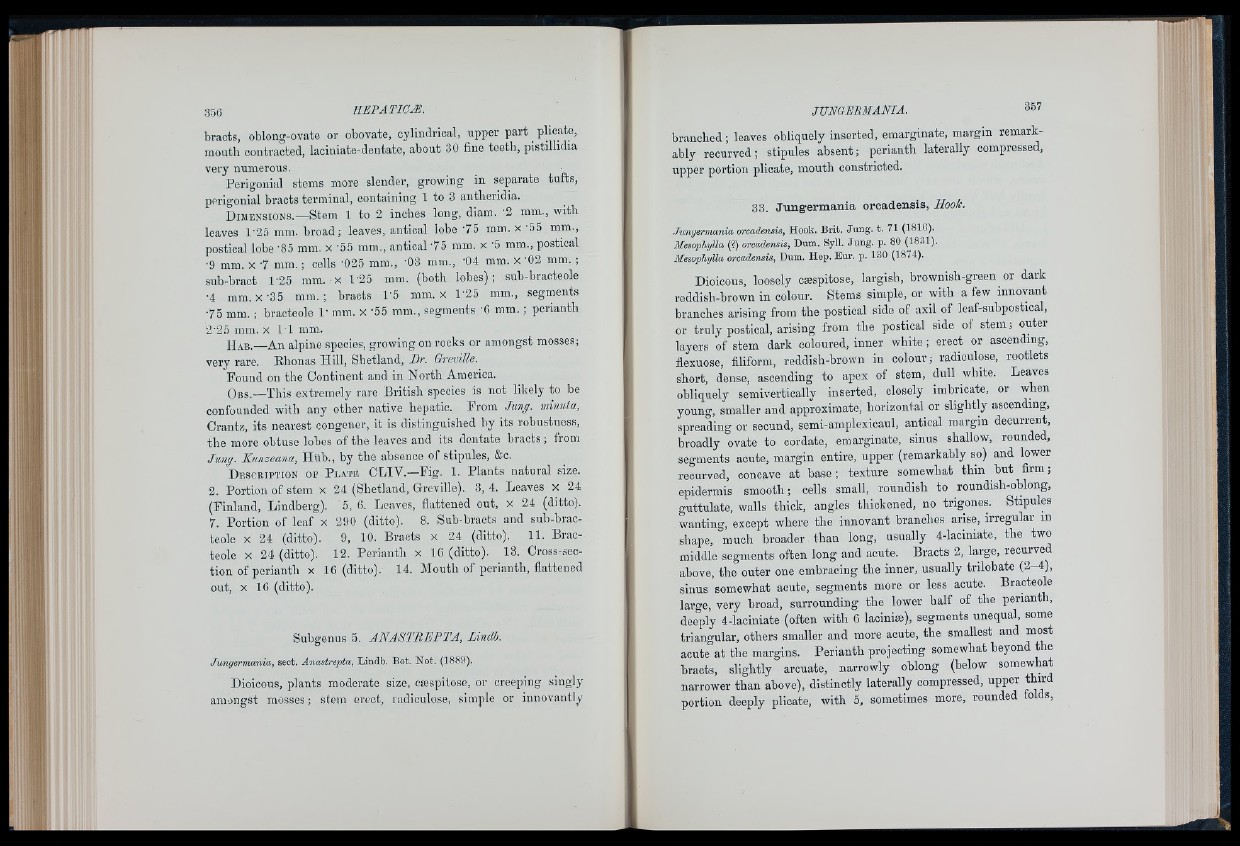
bracts, oblong-ovate or obovate, cylindrical, upper part ^ plicate,
mouth contracted, laciniate-dentate, about 30 fine teeth, pistillidia
very numerous.
Perigonial stems more slender, growing in separate tufts,
perigonial bracts terminal, containing 1 to 3 antheridia.
Dim en sio n s.— Stem 1 to 2 inches long, diam. '2 mm., with
leaves 1'25 mm. broad; leaves, antical lobe 7 5 mm. x '55 mm.,
postical lobe '85 mm. x ’55 ram., antical 75 mm. x ’5 mm., postical
■9 mm. X 7 mm.; cells '025 mm., '03 mm., '04 mm. x '0 2 mm. ;
sub-bract 1'25 ram. x 1'25 mm. (both lobes); sub-bracteole
•4 m m .x -35 mm.; bracts P5 mm.x T25 mm., segments
7 5 mm. ; bracteole 1' mm. x '55 mm., segments '6 mm.; perianth
2'25 mm. x 11 mm.
Hab.—An alpine species, growing on rocks or amongst mosses;
very rare. Ehonas Hill, Shetland, Dr. Greville.
Found on the Continent and in North America.
O bs.— This extremely rare British species is not likely to be
confounded with any other native hepatic. From Jung, minuta,
Crantz, its nearest congener, it is distinguished by its robustness,
the more obtuse lobes of the leaves and its dentate bracts; from
Jung. Kunzeana, Hüb., by the absence of stipules, &c.
D escription oe P late CLIV.—Fig. 1. Plants natural size.
2. Portion of stem x 24 (Shetland, Greville). 3, 4. Leaves x 24
(Finland, Lindberg). 5, 6. Leaves, flattened out, x 24 (ditto).
7. Portion of leaf x 290 (ditto). 8. Sub-bracts and suh-brac-
teole x 24 (ditto). 9, 10. Bracts x 24 (ditto). 11. Bracteole
x 24 (ditto). 12. Perianth x 10 (ditto). 13. Cross-section
of perianth X 16 (ditto). 14. Mouth of perianth, flattened
out, X 16 (ditto).
Subgenus 5. ANASTBEPTA, Lindb.
Jungermania, sect. Anastrepta, Lindb. Bot. Not. (1889).
Dioicous, plants moderate size, cæspitose, or creeping singly
amongst mosses ; stem erect, radiculose, simple or innovantly
branched ; leaves obliquely inserted, emarginate, margin remarkably
recurved; stipules absent; perianth laterally compressed,
upper portion plicate, mouth constricted.
33. Jungermania orcadensis, Hook.
.Tungermania orcadensis. Hook. Brit. Ju n g . t. 71 (1816).
Mesophylla (?) orcadensis, Dum. SyU. Ju n g . p. 80 (1831).
sis, Dum. Hep. Eur. p. 130 (1874).
Dioicous, loosely cæspitose, largish, brownish-green or dark
reddish-brown in colour. Stems simple, or with a few innovant
branohes arising from the postical side of axil of leaf-suhpostioal,
or truly postical, arising from the postieal side of stem; outer
layers of stem dark coloured, inner white ; erect or ascending,
flexuose, filiform, reddish-brown in colour; radiculose, rootlets
short, dense, ascending to apex of stem, dull white. Leaves
obliquely semivertically inserted, closely imbrioate, or when
young, smaller and approximate, horizontal or slightly ascending,
spreading or secund, semi-amplexicaul, antical margin decurrent,
broadly ovate to cordate, emarginate, sinus shallow, rounded,
segments acute, margin entire, upper (remarkably so) and lower
recurved, concave at base ; texture somewhat thin but firm ;
epidermis smooth; cells small, roundish to roundish-oblong,
guttulate, walls thick, angles thickened, no trigones. Stipules
wanting, except where the innovant branohes arise, irregular in
shape, much broader than long, usually 4-laciniate, the two
middle segments often long and acute. Bracts 2, large, recurved
above, the outer one embracing the inner, usually trilobate (2-4),
sinus somewhat acute, segments more or less acute. Braoteok
large, very broad, surrounding the lower half of the perianth,
deeply 4-laoiniate (often with 6 laciniæ), segments unequal, some
triangular, others smaller and more acute, the smallest and most
acute at the margins. Perianth projecting somewhat beyond ttie
bracts, slightly arcuate, narrowly oblong (below somewhat
narrower than above), distinctly laterally compressed, upper third
portion deeply plicate, with 5, sometimes more, rounded folds,